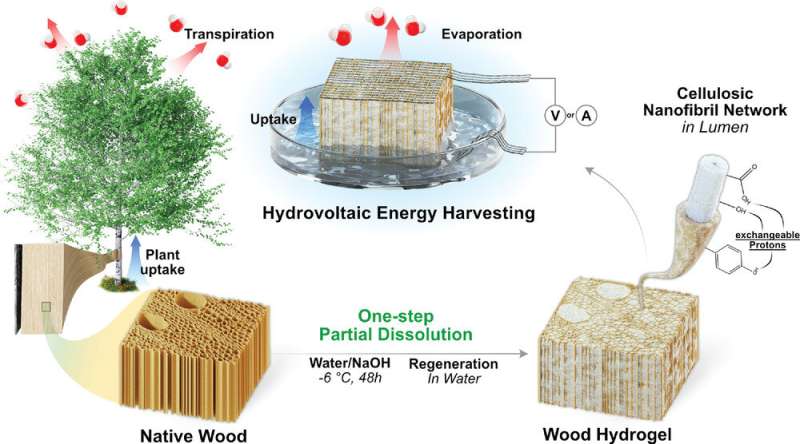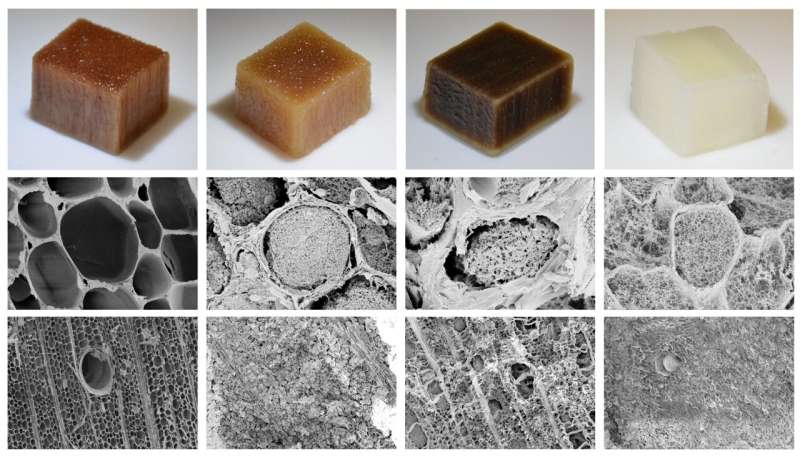Schematic of the formation of wood power generators. The left-hand side depicts the natural water uptake and transpiration of wood and its hierarchical structure. From the native wood, the one-step treatment is shown, leading to wood with precipitated nanofibrillated networks within the lumen and its abundance of functional groups. The final hydrovoltaic energy harvester is shown under operation. Blue arrow refers to water uptake and red arrow represents water evaporation. Credit: Advanced Functional Materials (2022). DOI: 10.1002/adfm.202208933
Water and wood may one day be all that's needed to provide electrical power for a household. At a time when energy is a critical issue for many millions of people worldwide, scientists in Sweden have managed to generate electricity with the help of these two renewable resources.
The method reported by researchers at KTH Royal Institute of Technology focuses on what naturally happens after wood is placed in water, and the water evaporates. Transpiration, a process in which water moves through a plant, is constantly occurring in nature. And it produces small amounts of electricity, known as bioelectricity.
Yuanyuan Li, assistant professor at the Division of Biocomposites at KTH, says that with some nanoengineering of wood—and pH tuning—small but promising amounts of electricity can now be harvested.
"At the moment we can run small devices such as an LED lamp or a calculator," Li says. "If we wanted to power a laptop, we would need about one square meter of wood about one centimeter thick, and about 2 liters of water."
"For a normal household we'd need far more material and water than that, so more research is needed."
By altering the nanoscale composition of wood, the researchers improved its properties in terms of surface area, porosity (or density), surface charge, how readily water can pass through the material and the water solution itself—all of which are factors that influence electricity generation in wood.
Highly porous nanoengineered wood for hydroelectricity harvesting was prepared through a one-step chemical treatment by immersing native wood (NW) into a water/NaOH mixture for 48 h at −6 °C. Credit: Yuanyuan Li
"We compared the porous structure in regular wood with the material we improved with regard to surface, porosity, surface charge and water transportation. Our measurements showed electricity generation that's 10 times higher than with natural wood," Li says.
She says that further tuning the pH difference between wood and water, due to an ion concentration gradient, achieves a potential of up to 1 volt and a remarkable power output of 1.35 microwatts per square centimeter.
Li says that to date, the wood manages to deliver high voltage for about 2-3 hours, before it begins to wane. So far the wood has managed 10 cycles with water, without a decline in the material's performance, she says.
"The great advantage of this technology is that the wood can readily be used for other purposes once it's depleted as an energy source, such as transparent paper, wood-based foam and different biocomposites."
The findings are published in the journal Advanced Functional Materials.
More information: Jonas Garemark et al, Advancing Hydrovoltaic Energy Harvesting from Wood through Cell Wall Nanoengineering, Advanced Functional Materials (2022). DOI: 10.1002/adfm.202208933
Journal information: Advanced Functional Materials
Provided by KTH Royal Institute of Technology

























